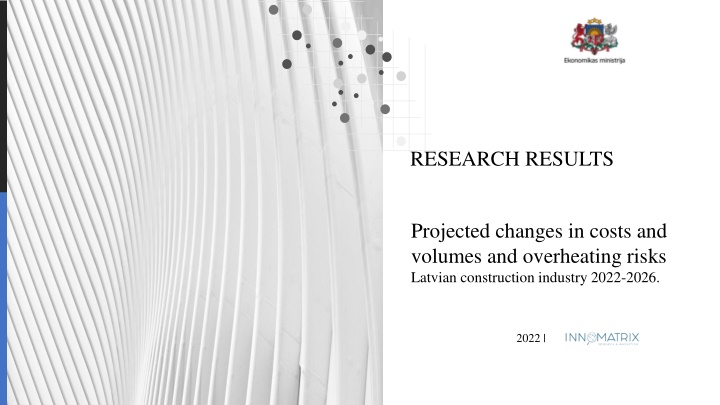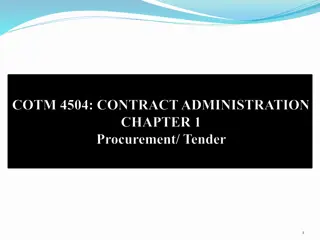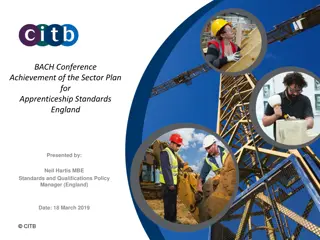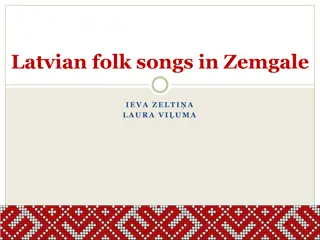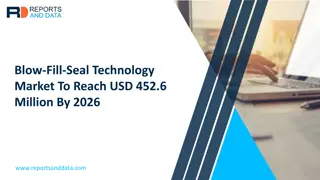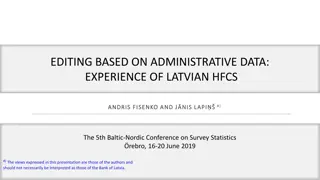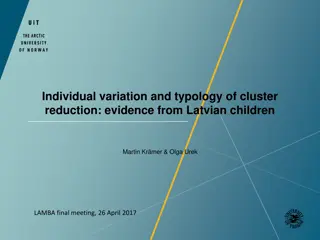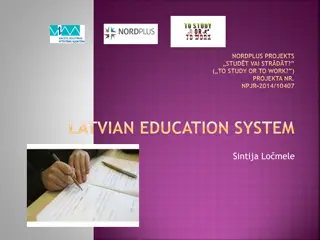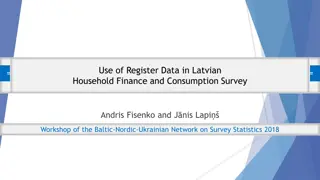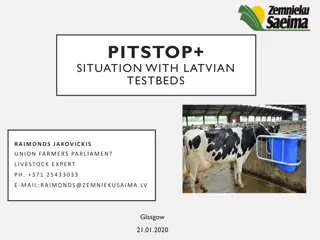Forecasted Changes in Latvian Construction Industry 2022-2026
Forecasted changes in costs and volumes, along with overheating risks, in the Latvian construction industry from 2022 to 2026 were analyzed by 83 experts. The research aims to aid in planning procurement costs efficiently and anticipate potential price fluctuations. Forecasts indicate a 0.9% increase in volume and a 20.5% rise in costs per annum, with marked variations between statistical and expert predictions.
Download Presentation

Please find below an Image/Link to download the presentation.
The content on the website is provided AS IS for your information and personal use only. It may not be sold, licensed, or shared on other websites without obtaining consent from the author.If you encounter any issues during the download, it is possible that the publisher has removed the file from their server.
You are allowed to download the files provided on this website for personal or commercial use, subject to the condition that they are used lawfully. All files are the property of their respective owners.
The content on the website is provided AS IS for your information and personal use only. It may not be sold, licensed, or shared on other websites without obtaining consent from the author.
E N D
Presentation Transcript
RESEARCH RESULTS Projected changes in costs and volumes and overheating risks Latvian construction industry 2022-2026. 2022 |
Purpose of the research To forecast changes in labour and building materials costs and possible overheating risks in the construction sector in Latvia in the period from 2022 to 2026 in order to be able to plan the potential costs of public construction procurements more efficiently and to assess possible price changes in the coming years 83 construction and economic experts involved: Bank of Latvia; Ministry of Finance; The Competition Council; Latvian Union of Architects; Latvian Association of Electrical Engineers and Energy Builders; Latvian Union of Geotechnicians; JSC "Latvijas valsts me i"; Latvian Builders' Association; Latvian Traders Association; Partnership of Latvian Construction Contractors; Latvian Union of Civil Engineers; the Ministry of Environmental Protection and Regional Development; University of Latvia; RTU; Ventspils University of Applied Sciences; RISEBA, AS "Sakret Holdings"; AS "SEB banka"; AS "Swedbank", SIA "Citrus Solutions"; Ogre Municipality Construction Board; "Ostas Celtnieks" Ltd.; Latvian State Roads, Ltd. "Limba uce i"; association "Latvijas ce ub v js", SIA "Optimera Latvia", etc.. Methodology: Researc conducted: Researchers: Updated forecasting methodology (initial 2018), which includes both combined forecasts. Scientists in the field of economics of the research organization InnoMatrix expert, statistical and 2022 in May, June and July
1. Cost and volume forecasts Content 2. Factors affecting costs 3. Assessment of the risks of overheating
2022 construction production growth forecast: 0.9% increase in volume and 20.5% in costs on an annual basis Changes in construction costs compared to the previous year 2020 2021 2022 2023 2024-2026 +1.3% +6.7% +14.9% +9.9% Combined forecast On average +8.7% per annum +20.5% +9.4% Expert forecasts On average +4.5% per annum Changes in construction output compared to the previous year 2020 2021 2022 2023 2024-2026 +2.7% -6.2% +1.1% -0.2% Combined forecast On average +2.0% per annum +0.9% -1.4% Expert forecasts On average +3.8% per annum
Marked variations between forecasts of changes in construction output and costs Changes in construction output compared to the previous year 2021 2022 2023 -6.2% Statistical forecast +1.3% Combined forecast +1.1% Expert forecast +0.9% Changes in construction costs compared to the previous year 2021 2022 +1.3% +6.7% Statistical forecast +9.2% Combined forecast +14.9% Expert forecast +20.5% 2020 +2.7% 2024 2025 2026 +0.9% -0.2% -1.4% +0.5% +2.3% +4.0% +0.1% +1.6% +3.0% -0.2% +2.2% +4.6% 2020 2023 2024 2025 2026 +10.4% +9.9% +9.4% +11.6% +8.2% +4.7% +12.9% +8.6% +4.4% +14.1% +9.3% +4.4%
The relatively fastest cost increase is expected in the construction of buildings 2022 +25.1% 2023 +14.3% 2024 +8.7% 202 +8.6% 2026. +7.8% Expert forecast of changes in construction costs of residential buildings Expert-examination of changes in construction costs of non-residential buildings Expert forecast of changes in construction costs of roads and highways Expert forecast of changes in construction costs of railways and metros Expert forecast of changes in the cost of construction of bridges and tunnels Expert-examination of changes in the construction costs of urban management infrastructure objects Expert-examination of changes in the cost of specialized construction works Expert forecast of changes in the cost of architectural and engineering services, technical inspection and analysis +26.6% +15.3% +9.0% +8.6% +8.2% +23.3% +9.7% +6.7% +6.0% +4.7% +25.0% +12.5% +8.5% +5.0% +3.5% +25.0% +11.0% +7.5% +5.0% +3.5% +21.3% +18.8% +8.0% +5.8% +4.5% +17.5% +12.0% +9.3% +5.3% +4.7% +14.0% +7.6% +8.8% +6.4% +7.6%
A markedly high cost increase in 2022 is expected for building materials and costs of machinery and equipment Identified high cost increase in ALL types of resources!
The cost of the most significant building materials Experts predict a significant increase in the cost of basic building materials in 2022 and a drop in cost growth in the period 2023-2026 in all positions The most significant increase in costs specifically for exterior finishing materials. Cost stabilization is planned for 2023-2026.
1/3 in the sale of building materials is formed by the costs of timber and metal products
Price dynamics of selected timber and metal products
Factors Factors affecting affecting costs costs 2022 2022
Factors affecting changes in the cost of building materials The most important factors affecting the cost of building materials Average expert evaluation 8,51 8,07 8,00 1 2 3 Average annual price of metal products in Latvia Average annual timber price in Latvia Average annual price of energy resources in Latvia During the year, the impact of metal and timber on the cost of building materials has intensified. A significant leap in the impact of energy prices. Specific problems the need to look for new delivery routes. The volume of construction is no longer such a significant factor as the prices of materials and energy. In the construction of urban infrastructure, higher sensitivity to the global impact of COVID-19.
Factors influencing changes in the cost of machinery and equipment The most important factors affecting the cost of machinery and equipment Average fuel price in Latvia Average annual price of energy resources in Latvia Competition concentration indicators in the machinery and equipment market in Latvia Average expert evaluation 1 2 3 8,33 7,92 6,22 A new factor with medium impact is the lack of competition in the market for machines and mechanisms. Specific factors are problems with the availability of spare parts and machines and mechanisms of individual brands.
Factors affecting changes in labour costs Main factors affecting labour costs Construction volume in Latvia Level of wages and salaries in the construction sector in EU countries EU labour demand in the construction sector Average expert evaluation 7,33 7,29 6,94 1 2 3 The impact of unique events - COVID-19, Rail Baltica, combating the shadow economy and digitalisation - on labour costs has been assessed as mediocre. Specific problems lack of specialists in certain professions, mid-level management, complexity of attracting guest workers and an increase in the amount of requirements. The construction of transport facilities is more sensitive to labour demand in the construction sectors of other EU countries.
Assessment of potential overheating of Latvian construction in 2022
7 overheating risk indicators
Construction Overheating Risk Index 0.66 for medium risk and 0.45 for high risk Of the seven indicators included, the weighted average of their actual value is 66% of the limit of the average risk of overheating and 45% of the high limit. Of the seven indicators examined, three are close to the overheating threshold assessed by experts the volume of housing loans, GDP growth rate and capital investment in buildings and structures by budgetary authorities. The other four indicators are at the currently safe level or with a tendency to reduced risk. Proportion of medium risk level Proportion of the high-risk level Indicators Weight 13% 40% 26% Share of job vacancies in construction sector Ratio of construction cost index to volume index of construction output 18% 48% 20% The ratio of wages and salaries per employee to productivity in construction 16% 69% 46% Gross capital investment of budgetary authorities in buildings and structures 15% 84% 68% Volume of newly issued loans for the purchase, reconstruction, repair of a dwelling 16% 86% 55% 11% 80% 63% GDP growth rate 11% 74% 49% Construction cost index by building materials group
Proposals 1. Competition authorities to analyse market concentration indicators in the trade sector of machinery and equipment and to develop measures to promote competition in order to reduce the costs of machinery and equipment. 2. Facilitate recruitment procedures for foreign labour and reduce bureaucratic barriers (waiting times required, wage requirements, etc.) in order to reduce labour cost jumps. 3. To provide support to companies in attracting new supply partners of raw materials, building materials and mechanisms to countries outside the countries involved in the Russo-Ukrainian war. 4. Develop a measure to slow down the lending of housing, if their volume goes to 200-250 mil. eur per quarter, while at the same time facilitating the redirection of loans to housing outside Riga and Pier ga. 5. Continue the measures taken to combat the shadow economy and develop new ones, taking into account the temporary tendency in the construction sector to increase the share of the shadow economy. 6. To develop the research methodology by reducing the number of questions in expert surveys, performing a more detailed analysis of overheating indicators and creating online tools for monitoring indicators characteristic of the construction industry.
Thank you! Projected changes in labour and building materials costs and assessment of overheating risks in the construction sector in Latvia in 2022-2026. 2022 |
